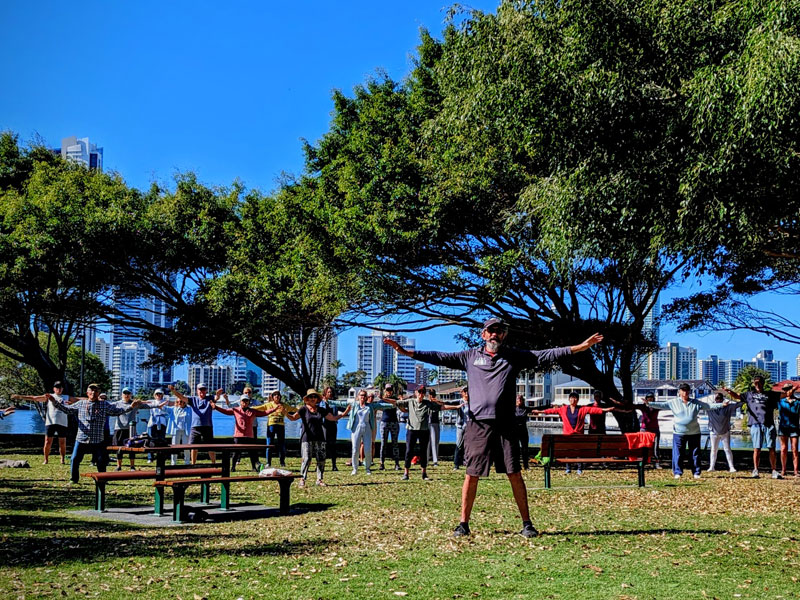WUSHU – The Chinese Way to Family Health and Fitness
With an Introduction by Dame Margot Fonteyn 1981
The traditional practice of Wushu is as old as Chinese culture itself, dating from the earliest Neolithic communities that first used tools and weapons to hunt for food and to defend themselves. The word literally means “martial art” and, as weapons became more sophisticated, so the forms of Wushu became more varied and complex and the techniques more refined. Chiaoti, a form of wrestling that was popular amongst soldiers, and Kanchiwu, an ancient dance performed with an axe and a shield, are both thought to represent stages of the early development of Wushu.
This curious mixture of a “martial art”, that has become in some measure a sport and a philosophical exercise, was developed from primitive times by working people, but, as the class structure emerged within Chinese society, it was adapted by the ruling classes. They perpetuated the mythical ideas surrounding the art, claiming that anyone who had mastered Wushu was invincible in the face of physical attack. And in an attempt to protect their power, the rulers began to shroud Wushu in religious mysticism and feudal superstition, actively discouraging participation.
It was only with the founding of the People’s Republic in 1949, and Chairman Mao’s order to promote physical culture and sports and build up the people’s health”, that every encouragement was suddenly given by the government to all aspects of Wushu — it was believed that people could play a far greater role .in the construction of the new socialist state if they improved their health. Thus Wushu became the base from which to strive for intellectual, moral and physical development. And, in finding a new purpose, it acquired a sense of joy that it previously lacked. Everywhere in China today, at dawn and dusk outside schools and factories, hospitals and shops, government offices and peasant dwellings, small children, their parents and grandparents can all be seen practising these many various forms of choreographed exercises. They are taught in schools and there are centres in every town and city, with volunteers giving free coaching to neighbourhood groups. Specialists in the art have developed new styles and techniques which are displayed at exhibitions and competitions.
Wushu, as it is now, includes a vast range of exercises that can be executed with weapons or bare-handed, with or without a partner, and they cater for all age groups. Traditionally there are two schools — the external and the internal. The external forms are sometimes hard and vigorous, involving much leaping, kicking and somersaulting. The internal school emphasizes soft, graceful, fluid movements that are similar to dancing.
The internal exercises include the classic twenty-four movements in the beautifully fluid Taijiquan, of which the form that creates opposing forces is somewhat akin to the isometrics that are already so popular in the West. These forms are for the elderly. In contrast, the external exercises include exercises for the new-born baby and playground exercises for school children in cities as well as those designed for country children, farmers’ exercises that include charming imitations of back-breaking peasant activities like clearing up scattered grain and pounding rice with a pestle. Then there are the exercises for office workers to perform in the equivalent of our coffee break and, finally, among the external exercises, are the popular movements in imitation of animals such as the bear, tiger, monkey and crane.
The internal exercises are closer in spirit to the martial origins of Wushu, but are, in fact, gentle forms of shadow boxing and swordplay with the emphasis on fluidity. Lastly there are exercises to prevent diseases and these call for the close coordination of movement and breathing. They stress relaxation, tranquillity and naturalness, and they promote strength and grace in harmony.
For centuries the Chinese have had a great understanding of the mind — body relationship. To those of us in the West who are encountering the ancient wisdom of the Chinese for the first time, Wushu is among the most exciting discoveries providing, if we wish, a fascinating exercise and fitness programme for the whole family — one that subtly engages the mind and spirit in choreographic patterns of great beauty, in the swift movements of a hunter, the sophisticated co-ordinations of an athlete, the delicate balances of a gymnast, the ritual movements of a seemingly ancient and forgotten religion.
Although I was brought up in China between the ages of nine and fourteen and have throughout my life retained a deep love of the country and her people, it was not until I was older that I understood the especial cultural significance of Wushu which, of course, I was aware of every day of my childhood in China. It is, in fact, the heritage of a unique people whose civilization was already far advanced when ours was as young as a bamboo shoot, and I, for one, deeply appreciate the opportunity this book gives to master some intricacies of a movement technique that is at once classical and modern, simple and profound, absorbing and satisfying.
Animal Play 2,100 years ago Animal play dates from the Han and Three Kingdoms periods when the first known physician in Chinese history, Huado (141—203), devised Wuqinxi to encourage physical fitness and improve health. Wuqinxi itself was based on even more ancient methods which mimicked the movements of animals and birds. The earliest illustrations of animal play were unearthed a few years ago in a general’s tomb dating from the Han Dynasty (about 200 BC). The drawings of men and women exercising in animal Postures are on a silk piece. Forty-four figures are depicted in different Postures.
Many of the drawings have broken lines and only a few captions are legible. Researchers, however, have been able to decipher the meaning of some of them. Breathing exercises can be identified in fig 1. Figs 3 and 11 are tiger poses and fig 4 is a monkey pose. Figs 6, 7, 15 and 16 are definitely the movements of a bird. Fig 12 is a bear pose and fig 8 is possibly a deer pose. The early Chinese also seemed to exercise with props, as can be seen from the woman body twisting in fig 10. Figs 2, 5, 9 and 14 are graceful movements that show that physical exercise had already assumed aesthetic forms in ancient times.
Dame Margot Fonteyn de Arias, DBE, was an English ballerina. She spent her entire career as a dancer with the Royal Ballet, eventually being appointed Prima Ballerina Assoluta of the company by Queen Elizabeth II.
Queenslands Performing Arts Center – Brisbane
Please join us for the Royal Ballet ‘Let’s Dance’ gala on Sat Jul 1st from 11am to 1pm at QPAC Melbourne Street green. We have two hours to present Tai Chi demonstrations, performances and lessons for the public. We hope to have as many instructors and students as possible attending – students of all levels welcome to participate. Come along, bring your friends to join-in or even just to watch the demonstrations, Master Rod’s ‘Gold Medal’ spectacular costumed performance of the “Dragon/Phoenix” Martial Art Fan is always captivating and not to be missed.


